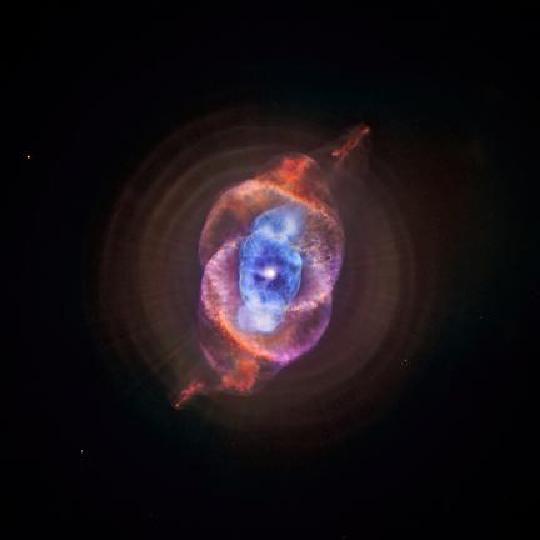
home •
about •
essential guide •
picture of the day •
thunderblogs •
news •
multimedia •
predictions •
products •
get involved •
contact
picture of the day archive subject index
Credit: X-ray: NASA/CXC/SAO; Optical: NASA/STScI
Aug 11, 2008
The Cat's Eye CatspawThe Cat’s Eye Nebula displays an abundance of plasma-discharge properties that leave standard gravity-and-hot-gas theories floundering.
The standard explanation of all so-called planetary nebulae, of which the Cat’s Eye is an example, is “star death.” As a star burns itself up, it evolves into a red giant that “boils off” a relatively slow-moving wind. At a critical stage, it collapses into a white dwarf, blowing off its atmosphere at a high speed. The high-speed wind catches up to the previous low-speed wind, collides with it, and produces shock waves that form bubbles, hot gas, and x-rays.
Astronomers have come to realize that the expected spherical shells of gas are actually hourglass-shaped structures and that the few spherical forms are the result of viewing them “looking down the barrel.” Various ad hoc hypotheses are appended to account for this bipolar symmetry, the filamentary structures, and other anomalous features.
The Electric Universe understands the Cat’s Eye to be a far-from-equilibrium electrical discharge in plasma. The evenly spaced radial filaments with concentric rings of increased luminosity are typical of the plasma focus discharge mechanism. The filaments tend to pair up, and several exhibit the braiding that develops as pairs of filaments spiral around their common axis.
The central “bubble” region, in red (optical) and blue (x-ray), marks out the rough “double helix” of Birkeland currents along the axis of the hourglass form. The axis is slightly tilted and perhaps “bent” to the line of sight. As is typical, the visible “ends” of the double helix are forked.
Thin double layers separate the cells of plasma from each other, and these double layers accelerate charge carriers, primarily electrons, to high velocities. In the blue region, these fast moving electrons spiral along the magnetic field and emit x-ray synchrotron radiation. Standard theorists often misinterpret this high-energy radiation as collisional emissions from a hot gas.
The image shown is the central region of the nebula. Outside this region lies an outer shell of the hourglass form with even more pronounced filamentation. The ring of luminosity that has formed where the threads of current have pinched down to a threshold of current density emphasize the view “down the barrel” of the discharge.
__________________________________________________________________________
Please visit our new "Thunderblog" page
Through the initiative of managing editor Dave Smith, we’ve begun the launch of a new
page called Thunderblog. Timely presentations of fact and opinion, with emphasis on
new discoveries and the explanatory power of the Electric Universe."The Electric Sky and The Electric Universe available now!

|
|

|
EXECUTIVE EDITORS:
David Talbott, Wallace Thornhill
MANAGING EDITORS:
Steve Smith, Mel Acheson
CONTRIBUTING EDITORS: Michael Armstrong, Dwardu Cardona,
Ev Cochrane,
C.J. Ransom, Don Scott, Rens van der Sluijs, Ian Tresman
WEBMASTER: Brian Talbott
Copyright 2007: thunderbolts.info
![]()
home •
thunderblogs •
forum •
picture of the day •
resources •
team •
updates •
contact us

